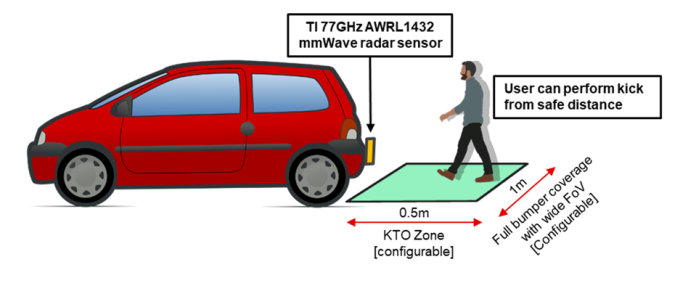Traditional power liftgates and trunks require users to press and hold a button on their key fob to activate the hatch. This can be a major inconvenience, especially when you’re trying to open the trunk while your hands are holding grocery bags. Hands-free systems such as kick-to-open tailgates enable you to open the trunk of your vehicle with a simple kick.
Many cars equipped with kick-to-open systems leverage capacitive or ultrasonic sensors to detect a kick which each have their own particular set of challenges. In this video, you can see how radar technology like TI’s millimeter-wave (mmWave) radar sensors can enable highly-accurate kick gesture detection.
Let’s take a closer look at how radar technology can offer a more reliable solution compared to other sensors.
Environmental challenges
Ultrasonic and capacitive sensors are susceptible to environmental factors that can adversely affect the reliability of kick sensors. Raindrops tend to either absorb or scatter ultrasonic waves that can alter the sensing range of ultrasonic-based kick-to-open systems, leading to an inability to detect a user’s kick within the expected range. Sometimes, interference from rain can also lead to false triggers.
With capacitive-based kick sensors, extreme temperatures, moisture, or dust and debris can compromise reliable kick detection performance. In cold weather conditions in particular, capacitive-based solutions may become less responsive to kick gestures as a result of reduced electrical conductivity.
mmWave radar sensors are less susceptible to environmental factors and offer more consistent and reliable kick detection even in the presence of rain, snow or fog, making radar-based kick-to-open systems far more dependable and user-friendly in adverse weather conditions.
Detection range and field-of-view limitations
Capacitive- and ultrasonic-based kick-to-open systems have several limitations when it comes to detection range and field of view. Users must get in such close proximity to the rear bumper of the vehicle that the tailgate will often activate only if they kick directly under the bumper, potentially putting them in the path of the tailgate while it is opening or closing.
The extended detection range of TI’s 77-GHz AWRL1432 mmWave radar sensor allows users to activate the trunk from a safe distance behind the bumper as they approach the vehicle, minimizing any potential risk of injury from the tailgate. Additionally, the wider-angle coverage of the AWRL1432 enables it to detect kick gestures from various directions rather than kicking with precise positioning or at a particular angle. The AWRL1432 even allows you to design in the ability for users to define the distance from which they want to trigger trunk activation, as shown in Figure 1.
Foot gesture detection challenges
While existing kick-to-open systems are designed to recognize specific gestures, they often mistake random movements in the vicinity of the vehicle for intentional kick gestures, or vice versa. With gesture recognition accuracy greater than 90%, TI’s 77-GHz AWRL1432 radar sensors can enable accurate and precise recognition of kick gestures for activating the tailgate. The AWRL1432 comes with two transmit and three receive channels for increased resolution, coupled with integrated processing from an Arm® Cortex®-M4 microcontroller and a hardware accelerator for processing at the edge. On-chip advanced signal-processing algorithms help distinguish between an intentional kick and other random movement, a benefit that is especially valuable in crowded environments.
Conclusion
TI designed the AWRL1432 with cost and power consumption in mind. The ability to support up to five different gestures enables a level of flexibility for kick-to-open systems, such as designating different functionalities for different gestures. For example, a hand gesture could trigger the front trunk in electric vehicles, while a kick gesture triggers the rear trunk. It is also possible to harness the integrated processing and multiple transmit and receive channels onboard the AWRL1432 to integrate features such as obstacle detection.









